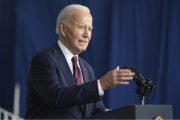
The NSA and FBI are “tapping directly into the central servers of nine leading U.S. Internet companies, extracting audio, video, photographs, e-mails, documents and connection logs that enable analysts to track a person’s movements and contacts over time,” the Washington Post reported Thursday evening. The news came just one day after the British newspaper The Guardian reported about the National Security Agency’s daily collection of the telephone logs of all Verizon’s U.S. customers.
The secret program, called PRISM, has been in operation since 2007, but has not been disclosed publicly before, the Post said. A career intelligence officer provided PowerPoint slides and supporting materials to the paper to expose the massive invasion of privacy. “They quite literally can watch your ideas form as you type,” the officer said.
The companies participating in the program include most of the big names in the telecommunications industry — Microsoft, Yahoo, Google, Facebook, PalTalk, AOL, Skype, YouTube, and Apple. The program has grown out of a history of alliances between U.S. intelligence agencies and as many as 100 U.S. companies since the 1970s, the Post reports. PRISM works in conjunction with another top-secret program, called BLARNEY, which, according to the program’s summary, “leverages IC [intelligence community] and commercial partnerships to gain access and exploit foreign intelligence obtained from global networks.”
PRISM allows the NSA to enter a company’s data stream and extract communications by keying in “selectors” or search items. The agency is mandated by law to conduct surveillance only on foreign operations within the United States, but the selectors are designed to produce at least 51 percent confidence in the “foreignness” of the data it collects, meaning it could be intercepting wholly domestic communications nearly half of the time. Training materials instruct new analysts to submit accidentally collected U.S. content for a quarterly report. But the training instructions also tell the analysts that “it’s nothing to worry about,” the Post said.
Even when intercepting foreign intelligence, domestic communications are inevitably caught in the net. Everyone in the foreign suspect’s inbox or outbox is swept in and analysts are taught to follow the chain of communications two “hops” out from the target, increasing exponentially the number of persons and messages that come under surveillance.
PRISM resembles the warrantless surveillance program begun by Bush administration after the terrorist attacks on New York and Washington on September 11, 2001. That program produced a storm of outrage when it was made public in 2006, some of it coming from then-Senator and presidential hopeful Barack Obama. But Congress gave companies that participated in the program immunity from lawsuits over privacy violations by passing legislation that also gave the Justice Department authority to compel companies to comply with secret orders from the Foreign Intelligence Surveillance Courts to turn over customer records. Sen. Obama was among those voting in favor of that legislation, which President Bush signed into law.
An internal presentation, prepared for senior analysts in the NSA’s Signals Intelligence Directorate, called PRISM the largest contributor of information that goes into the President’s Daily Brief (PDB), the Post reported. The PDB cited PRISM data in 1,477 articles last year. According to the briefing slides the Post received, “NSA reporting increasingly relies on PRISM,” which accounts for nearly one in seven intelligence reports.
The National Security Agency, the successor to the Armed Forces Security Agency, was created in 1952 by order of President Harry Truman in a letter that was itself classified. The government denied the existence of the agency for so long that it became known as “No Such Agency.” Yet it grew through the years and decades to such an extent that in their 2010 Washington Post series “Top Secret America,” Dana Priest and William Arkin wrote: “Every day, collection systems at the National Security Agency intercept and store 1.7 billion e-mails, phone calls and other types of communications.”
Estimates of its number of employees range from 35,000 to 55,000. Its headquarters is behind the walls of Fort Meade in Maryland, but a new million-square-foot surveillance center is under construction in the Utah desert. The project is expected to cost $2 billion by the time it is completed, possibly as early as this fall. James Bamford, an author who has written extensively about the NSA, estimated the new surveillance center could store data equal to 500 quintillion pages.
By 2010, Priest and Arkin wrote, 33 building complexes for top-secret intelligence work in Washington, D.C. and the surrounding area had been built or were then under construction since September, 2001. Has all that intelligence effort and the vast amounts of money spent on it made us safer? We may never know, since it’s all “top-secret.” But the writers made an interesting point about the famous “underwear bomber” who tried unsuccessfully to detonate an explosive device he was wearing aboard a plane as it was about to land in Detroit on December 25, 2009. The Christmas Day bomber, they wrote, was detected, “not by the thousands of analysts employed to find lone terrorists but by an alert airline passenger who saw smoke coming from his seatmate.”
Perhaps Americans today are noticing smoke emanating from the Bill of Rights. There is no way that the NSA’s interception and storage of some 1.7 billion communications every day conforms to the Fourth Amendment requirement that a government search be reasonable and focused on a particular “place to be searched and person or things to be seized.” Back when the Supreme Court was dealing with the question of whether warrantless eavesdropping on people’s telephone conversations was as much a violation of the Fourth Amendment as the opening of their mail, Justice Louis Brandeis wrote in a famous dissent:
“The makers of our Constitution … conferred, as against the Government, the right to be let alone — the most comprehensive of rights, and the right most valued by civilized men.”



